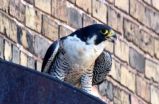(Press-News.org) (Santa Barbara, Calif.) — The rapid conversion of natural lands to cement-dominated urban centers is causing great losses in biodiversity. Yet, according to a new study involving 147 cities worldwide, surprisingly high numbers of plant and animal species persist and even flourish in urban environments — to the tune of hundreds of bird species and thousands of plant species in a single city.
Contrary to conventional wisdom that cities are a wasteland for biodiversity, the study found that while a few species — such as pigeons and annual meadow grass — are shared across cities, overall the mix of species in cities reflects the unique biotic heritage of their geographic location. The findings of the study conducted by a working group at UC Santa Barbara's National Center for Ecological Analysis and Synthesis (NCEAS) and funded by the National Science Foundation were published today in the Proceedings B, a journal of the Royal Society of Biological Sciences.
"While urbanization has caused cities to lose large numbers of plants and animals, the good news is that cities still retain endemic native species, which opens the door for new policies on regional and global biodiversity conservation," said lead author and NCEAS working group member Myla F. J. Aronson, a research scientist in the Department of Ecology, Evolution and Natural Resources at Rutgers, The State University of New Jersey.
The study highlights the value of green space in cities, which have become important refuges for native species and migrating wildlife. This phenomenon has been named the Central Park Effect because of the surprisingly large number of species found in New York's Central Park, a relatively small island of green within a metropolis.
Unlike previous urban biodiversity research, this study looks beyond the local impacts of urbanization and considers overall impacts on global biodiversity. The research team created the largest global dataset to date of two diverse taxa in cities: birds (54 cities) and plants (110 cities).
Findings show that many plant and animal species, including threatened and endangered species, can flourish in cities, even as others decline or disappear entirely. Cities with more natural habitats support more bird and plant species and experience less loss in species as the city grows. Overall, cities supported far fewer species (about 92 percent less for birds and 75 percent less for native plants) than expected for similar areas of undeveloped land.
"We do pay a steep price in biodiversity as urbanization expands," said coauthor Frank La Sorte, a research associate at the Cornell Lab of Ornithology. "But even though areas that have been urbanized have far fewer species, we found that those areas retain a unique regional flavor. That uniqueness is something that people can take pride in retaining and rebuilding."
Conserving green spaces, restoring native plant species and adding biodiversity-friendly habitats within urban landscapes could, in turn, support more bird and plant species. "It is true that cities have already lost a substantial proportion of their region's biodiversity," said Madhusudan Katti, a faculty member in the Department of Biology at California State University, Fresno. "This can be a cup half-full or half-empty scenario. If we act now and rethink the design of our urban landscapes, cities can play a major role in conserving the remaining native plant and animal species and help bring back more of them."
The human experience is increasingly defined within an urban context, the authors noted. They maintain it is still possible for a connection to the natural world to persist in an urban setting, but it will require planning, conservation and education.
"Given that the majority of people now live in cities, this group's synthesis of data on plant and urban plant and animal diversity should be of broad interest to ecologists as well as urban and landscape planners," said Frank Davis, NCEAS director.
INFORMATION: END
Cities support more native biodiversity than previously thought
Researchers at UCSB's NCEAS compile the largest global dataset of urban birds and plants, which shows world's cities retain a unique natural palette
2014-02-12
ELSE PRESS RELEASES FROM THIS DATE:
4 years on, ICU Patients with kidney injury show high mortality & elevated urinary protein
2014-02-12
In 4 years of follow up of 1464 participants in the randomized controlled trial Randomised Evaluation of Normal vs. Augmented Levels of RRT (RENAL) study, Martin Gallagher (The George Institute for Global Health, Sydney, Australia) and colleagues found that patients with acute kidney injury (AKI) in an intensive care unit (ICU) who require renal replacement therapy (RRT; hemodialysis combined with hemofiltration) do not benefit from higher intensity RRT. At a median of 43.9 months follow up, mortality (63% in the low intensity and 63% in the high intensity group), as well ...
Study challenges a close link between recent weight gain and diabetes
2014-02-12
It is a common notion that type 2 diabetes is precipitated by substantial progressive weight gain, but a study published this week in PLOS Medicine suggests that this might not be true.
Dorte Vistisen and Kristine Færch, from the Steno Diabetes Center in Gentofte, Denmark, and colleagues analyzed data from participants of the Whitehall II cohort, a group of London-based civil servants who have been followed for more than a decade, to see what changes in body weight and other parameters had occurred in people in the years before they were diagnosed with diabetes.
6,705 ...
What makes memories last?
2014-02-12
Prions can be notoriously destructive, spurring proteins to misfold and interfere with cellular function as they spread without control. New research, publishingin the open access journal PLOS Biology on February 11 2014, from scientists at the Stowers Institute for Medical Research reveals that certain prion-like proteins, however, can be precisely controlled so that they are generated only in a specific time and place. These prion-like proteins are not involved in disease processes; rather, they are essential for creating and maintaining long-term memories.
"This protein ...
Fifty-five genes linked to a powerful tumor suppressor predict breast cancer survival
2014-02-12
WASHINGTON — A panel of 55 genes, almost all of which are impacted by the loss of a particular protein, appears to predict if breast cancer will become invasive, leading to poorer survival, researchers at Georgetown Lombardi Comprehensive Cancer Center report in PLOS ONE.
The panel represents loss of a powerful tumor suppressor gene, SYK, as well as genetic alterations in 51 other genes that are directly affected by the loss of a copy of the SYK gene and the absence of its protein.
"Without SYK, the protein it makes, and genetic disruption in a set of genes thought ...
Kidney failure risk for organ donors 'extremely low'
2014-02-12
The risk of a kidney donor developing kidney failure in the remaining organ is much lower than in the population at large, even when compared with people who have two kidneys, according to results of new Johns Hopkins research.
The results, published in the Feb. 12 issue of the Journal of the American Medical Association, describes what is believed to be the largest study ever conducted of kidney disease risk in living kidney donors, encompassing all such donors in the United States over a 17-year period. The same researchers reporting in the same journal also showed ...
Study finds small increased risk of kidney disease following kidney donation
2014-02-12
An analysis of nearly 100,000 kidney donors finds that there is a small increased lifetime risk of developing end-stage renal disease following donation compared with healthy nondonors, although the risk is still much lower than that in the general population, according to a study in the February 12 issue of JAMA.
Every year in the United States, approximately 6,000 healthy adults accept the risks of kidney donation to help family members, friends, or even strangers. "It is imperative that the transplant community, in due diligence to donors, understands the risk of ...
Preterm infants more likely to have elevated insulin levels in early childhood
2014-02-12
Researchers have found that preterm infants are more likely to have elevated insulin levels at birth and in early childhood compared to full-term infants, findings that provide additional evidence that preterm birth may be a risk factor for type 2 diabetes, according to a study in the February 12 issue of JAMA.
In the United States, 1 in 9 live births are preterm, and l in 5 live births among African Americans are preterm. "There is growing evidence that fetal and early life events may result in permanent metabolic alterations, such as type 2 diabetes and metabolic syndrome ...
Fewer doses of HPV vaccine still results in reduced risk of STD
2014-02-12
Although maximum reduction in the risk of genital warts (condylomata) was seen after 3 doses of human papillomavirus (HPV) vaccine, receipt of 2 vaccine doses was associated with considerable reduction in risk, particularly among women who were younger than 17 years at first vaccination, according to a study in the February 12 issue of JAMA.
HPV infection causes genital warts and cervical cancer, and HPV vaccine prevents both. The typical dose schedule requires 3 doses of vaccine, but small clinical trials have reported measures of vaccine efficacy with fewer than 3 ...
Hospital readmission rate varies following care at rehabilitation facility
2014-02-12
Among rehabilitation facilities providing services to Medicare fee-for-service patients, 30-day hospital readmission rates vary, from about 6 percent for patients with lower extremity joint replacement to nearly 20 percent for patients with debility (weakness or feebleness), according to a study in the February 12 issue of JAMA.
The Centers for Medicare & Medicaid Services (CMS) recently identified 30-day hospital readmission as a national quality indicator for inpatient rehabilitation facilities; reporting will be required in 2014 by the CMS, according to background ...
Study examines legislative challenges to school immunization mandates
2014-02-12
From 2009-2012, 36 bills introduced in 18 states sought to modify school immunization mandates, with the majority seeking to expand exemptions although none of the bills passed, according to a study in the February 12 issue of JAMA.
"School immunization mandates, implemented through state-level legislation, have played an important role in maintaining high immunization coverage in the United States," according to background information in the article. Immunization mandates permit exemptions that vary from state to state in terms of type of exemption (e.g., religious, ...
LAST 30 PRESS RELEASES:
Tracing the quick synthesis of an industrially important catalyst
New software sheds light on cancer’s hidden genetic networks
UT Health San Antonio awarded $3 million in CPRIT grants to bolster cancer research and prevention efforts in South Texas
Third symposium spotlights global challenge of new contaminants in China’s fight against pollution
From straw to soil harmony: International team reveals how biochar supercharges carbon-smart farming
Myeloma: How AI is redrawing the map of cancer care
Manhattan E. Charurat, Ph.D., MHS invested as the Homer and Martha Gudelsky Distinguished Professor in Medicine at the University of Maryland School of Medicine
Insilico Medicine’s Pharma.AI Q4 Winter Launch Recap: Revolutionizing drug discovery with cutting-edge AI innovations, accelerating the path to pharmaceutical superintelligence
Nanoplastics have diet-dependent impacts on digestive system health
Brain neuron death occurs throughout life and increases with age, a natural human protein drug may halt neuron death in Alzheimer’s disease
SPIE and CLP announce the recipients of the 2025 Advanced Photonics Young Innovator Award
Lessons from the Caldor Fire’s Christmas Valley ‘Miracle’
Ant societies rose by trading individual protection for collective power
Research reveals how ancient viral DNA shapes early embryonic development
A molecular gatekeeper that controls protein synthesis
New ‘cloaking device’ concept to shield sensitive tech from magnetic fields
Researchers show impact of mountain building and climate change on alpine biodiversity
Study models the transition from Neanderthals to modern humans in Europe
University of Phoenix College of Doctoral Studies releases white paper on AI-driven skilling to reduce burnout and restore worker autonomy
AIs fail at the game of visual “telephone”
The levers for a sustainable food system
Potential changes in US homelessness by ending federal support for housing first programs
Vulnerability of large language models to prompt injection when providing medical advice
Researchers develop new system for high-energy-density, long-life, multi-electron transfer bromine-based flow batteries
Ending federal support for housing first programs could increase U.S. homelessness by 5% in one year, new JAMA study finds
New research uncovers molecular ‘safety switch’ shielding cancers from immune attack
Bacteria resisting viral infection can still sink carbon to ocean floor
Younger biological age may increase depression risk in older women during COVID-19
Bharat Innovates 2026 National Basecamp Showcases India’s Most Promising Deep-Tech Ventures
Here’s what determines whether your income level rises or falls
[Press-News.org] Cities support more native biodiversity than previously thoughtResearchers at UCSB's NCEAS compile the largest global dataset of urban birds and plants, which shows world's cities retain a unique natural palette


